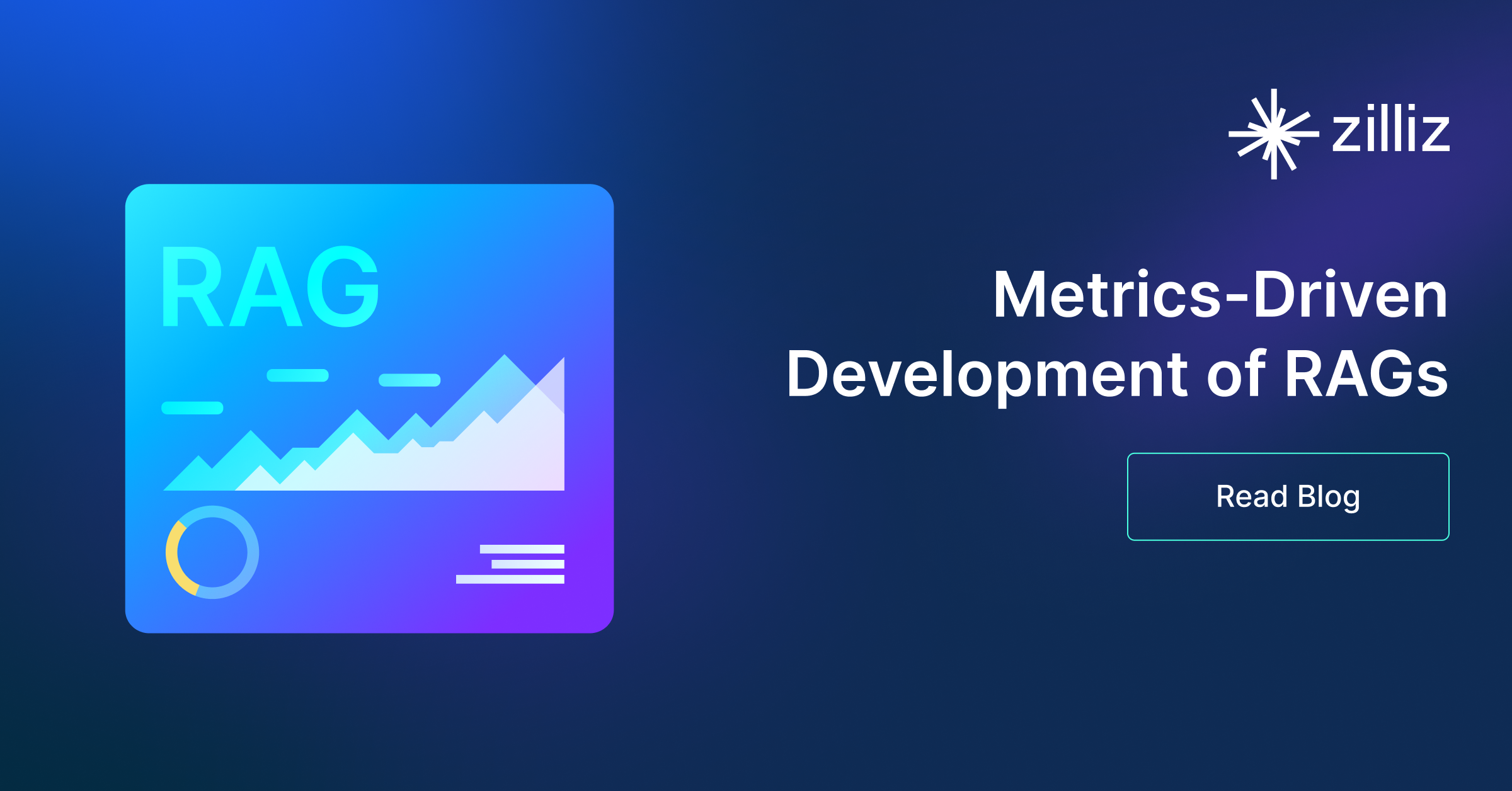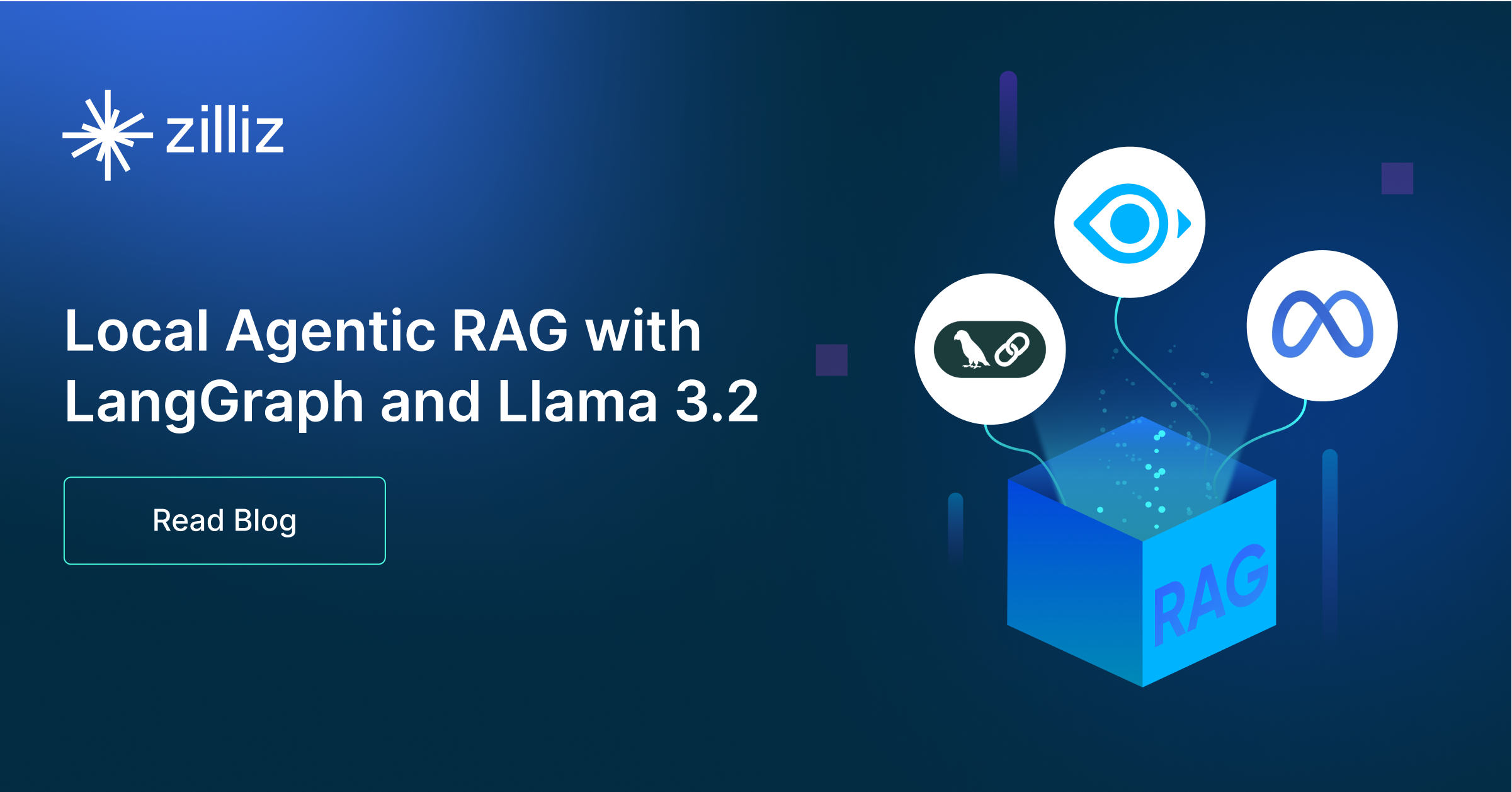Build RAG Chatbot with LangChain, LangChain vector store, Anthropic Claude 3 Haiku, and Azure text-embedding-ada-002
Introduction to RAG
Retrieval-Augmented Generation (RAG) is a game-changer for GenAI applications, especially in conversational AI. It combines the power of pre-trained large language models (LLMs) like OpenAI’s GPT with external knowledge sources stored in vector databases such as Milvus and Zilliz Cloud, allowing for more accurate, contextually relevant, and up-to-date response generation. A RAG pipeline usually consists of four basic components: a vector database, an embedding model, an LLM, and a framework.
Key Components We'll Use for This RAG Chatbot
This tutorial shows you how to build a simple RAG chatbot in Python using the following components:
- LangChain: An open-source framework that helps you orchestrate the interaction between LLMs, vector stores, embedding models, etc, making it easier to integrate a RAG pipeline.
- LangChain in-memory vector store: an in-memory, ephemeral vector store that stores embeddings in-memory and does an exact, linear search for the most similar embeddings. The default similarity metric is cosine similarity, but can be changed to any of the similarity metrics supported by ml-distance. It is intended for demos and does not yet support ids or deletion. (If you want a much more scalable solution for your apps or even enterprise projects, we recommend using Zilliz Cloud, which is a fully managed vector database service built on the open-source Milvusand offers a free tier supporting up to 1 million vectors.)
- Anthropic Claude 3: This advanced AI language model from Anthropic focuses on safety and alignment, capable of generating coherent and context-aware text. It excels in creative writing, conversational AI, and insightful summarization. Ideal for creating engaging content while ensuring adherence to ethical standards and user intent.
- Azure text-embedding-ada-002: This model specializes in generating high-quality text embeddings, enabling effective semantic search and natural language understanding. Its strengths lie in producing contextually rich representations that enhance tasks like text classification, clustering, and recommendation systems, making it ideal for applications in content discovery and personalized user experiences.
By the end of this tutorial, you’ll have a functional chatbot capable of answering questions based on a custom knowledge base.
Note: Since we may use proprietary models in our tutorials, make sure you have the required API key beforehand.
Step 1: Install and Set Up LangChain
%pip install --quiet --upgrade langchain-text-splitters langchain-community langgraph
Step 2: Install and Set Up Anthropic Claude 3 Haiku
pip install -qU "langchain[anthropic]"
import getpass
import os
if not os.environ.get("ANTHROPIC_API_KEY"):
os.environ["ANTHROPIC_API_KEY"] = getpass.getpass("Enter API key for Anthropic: ")
from langchain.chat_models import init_chat_model
llm = init_chat_model("claude-3-haiku-20240307", model_provider="anthropic")
Step 3: Install and Set Up Azure text-embedding-ada-002
pip install -qU langchain-openai
import getpass
import os
if not os.environ.get("AZURE_OPENAI_API_KEY"):
os.environ["AZURE_OPENAI_API_KEY"] = getpass.getpass("Enter API key for Azure: ")
from langchain_openai import AzureOpenAIEmbeddings
embeddings = AzureOpenAIEmbeddings(
azure_endpoint=os.environ["AZURE_OPENAI_ENDPOINT"],
azure_deployment=os.environ["AZURE_OPENAI_DEPLOYMENT_NAME"],
openai_api_version=os.environ["AZURE_OPENAI_API_VERSION"],
)
Step 4: Install and Set Up LangChain vector store
pip install -qU langchain-core
from langchain_core.vectorstores import InMemoryVectorStore
vector_store = InMemoryVectorStore(embeddings)
Step 5: Build a RAG Chatbot
Now that you’ve set up all components, let’s start to build a simple chatbot. We’ll use the Milvus introduction doc as a private knowledge base. You can replace it with your own dataset to customize your RAG chatbot.
import bs4
from langchain import hub
from langchain_community.document_loaders import WebBaseLoader
from langchain_core.documents import Document
from langchain_text_splitters import RecursiveCharacterTextSplitter
from langgraph.graph import START, StateGraph
from typing_extensions import List, TypedDict
# Load and chunk contents of the blog
loader = WebBaseLoader(
web_paths=("https://milvus.io/docs/overview.md",),
bs_kwargs=dict(
parse_only=bs4.SoupStrainer(
class_=("doc-style doc-post-content")
)
),
)
docs = loader.load()
text_splitter = RecursiveCharacterTextSplitter(chunk_size=1000, chunk_overlap=200)
all_splits = text_splitter.split_documents(docs)
# Index chunks
_ = vector_store.add_documents(documents=all_splits)
# Define prompt for question-answering
prompt = hub.pull("rlm/rag-prompt")
# Define state for application
class State(TypedDict):
question: str
context: List[Document]
answer: str
# Define application steps
def retrieve(state: State):
retrieved_docs = vector_store.similarity_search(state["question"])
return {"context": retrieved_docs}
def generate(state: State):
docs_content = "\n\n".join(doc.page_content for doc in state["context"])
messages = prompt.invoke({"question": state["question"], "context": docs_content})
response = llm.invoke(messages)
return {"answer": response.content}
# Compile application and test
graph_builder = StateGraph(State).add_sequence([retrieve, generate])
graph_builder.add_edge(START, "retrieve")
graph = graph_builder.compile()
Test the Chatbot
Yeah! You've built your own chatbot. Let's ask the chatbot a question.
response = graph.invoke({"question": "What data types does Milvus support?"})
print(response["answer"])
Example Output
Milvus supports various data types including sparse vectors, binary vectors, JSON, and arrays. Additionally, it handles common numerical and character types, making it versatile for different data modeling needs. This allows users to manage unstructured or multi-modal data efficiently.
Optimization Tips
As you build your RAG system, optimization is key to ensuring peak performance and efficiency. While setting up the components is an essential first step, fine-tuning each one will help you create a solution that works even better and scales seamlessly. In this section, we’ll share some practical tips for optimizing all these components, giving you the edge to build smarter, faster, and more responsive RAG applications.
LangChain optimization tips
To optimize LangChain, focus on minimizing redundant operations in your workflow by structuring your chains and agents efficiently. Use caching to avoid repeated computations, speeding up your system, and experiment with modular design to ensure that components like models or databases can be easily swapped out. This will provide both flexibility and efficiency, allowing you to quickly scale your system without unnecessary delays or complications.
LangChain in-memory vector store optimization tips
LangChain in-memory vector store is just an ephemeral vector store that stores embeddings in-memory and does an exact, linear search for the most similar embeddings. It has very limited features and is only intended for demos. If you plan to build a functional or even production-level solution, we recommend using Zilliz Cloud, which is a fully managed vector database service built on the open-source Milvus and offers a free tier supporting up to 1 million vectors.)
Anthropic Claude 3 Haiku optimization tips
Claude 3 Haiku is designed for efficiency, making it a great choice for low-latency RAG applications. Optimize token usage by structuring prompts concisely, removing redundant text, and leveraging system messages effectively to guide responses. Use function calling when applicable to offload structured processing tasks and improve response reliability. Batch process queries where possible to reduce API overhead and enhance throughput. If latency is critical, consider caching frequent queries and pre-generating responses for common questions. Fine-tune response control with temperature and top-p sampling; lower temperature values (e.g., 0.2-0.3) help maintain consistency in factual retrieval tasks. Use streaming mode for real-time applications to get faster partial responses while processing large prompts. Regularly evaluate and adjust model parameters based on performance benchmarks to balance speed and accuracy in your RAG pipeline.
Azure text-embedding-ada-002 Optimization Tips
To optimize the Azure text-embedding-ada-002 component in your Retrieval-Augmented Generation (RAG) setup, ensure that you batch your requests effectively to reduce latency and maximize throughput; try grouping up to 1000 tokens per request if possible. Preprocess your input data to remove unnecessary noise and stop words, which can improve embedding quality. Adjust the model’s parameters to suit your specific use case, focusing on the length of input sequences and maintaining token limits. Utilize caching mechanisms for frequently queried inputs to speed up retrieval, and regularly fine-tune your embeddings with domain-specific data to enhance relevance. Finally, monitor and analyze performance metrics continuously to make iterative adjustments that cater to any shifts in data patterns or retrieval needs.
By implementing these tips across your components, you'll be able to enhance the performance and functionality of your RAG system, ensuring it’s optimized for both speed and accuracy. Keep testing, iterating, and refining your setup to stay ahead in the ever-evolving world of AI development.
RAG Cost Calculator: A Free Tool to Calculate Your Cost in Seconds
Estimating the cost of a Retrieval-Augmented Generation (RAG) pipeline involves analyzing expenses across vector storage, compute resources, and API usage. Key cost drivers include vector database queries, embedding generation, and LLM inference.
RAG Cost Calculator is a free tool that quickly estimates the cost of building a RAG pipeline, including chunking, embedding, vector storage/search, and LLM generation. It also helps you identify cost-saving opportunities and achieve up to 10x cost reduction on vector databases with the serverless option.
 Calculate your RAG cost
Calculate your RAG cost
What Have You Learned?
By diving into this tutorial, you’ve unlocked the power of combining cutting-edge tools to build a Retrieval-Augmented Generation (RAG) system from the ground up! You learned how LangChain acts as the glue, seamlessly orchestrating the flow of data between components. With the LangChain vector store, you saw how to efficiently store and retrieve embeddings generated by Azure’s text-embedding-ada-002, transforming raw text into meaningful numerical representations. Then, Anthropic’s Claude 3 Haiku stepped in as the LLM powerhouse, leveraging those retrieved contexts to generate precise, context-aware answers. This pipeline isn’t just functional—it’s optimized! You discovered tips like chunking strategies to balance speed and accuracy, and even explored how to use the free RAG cost calculator to estimate expenses and fine-tune your setup for budget-friendly scalability.
But this isn’t just about following steps—it’s about empowerment. You’ve seen how these tools work in harmony to turn abstract concepts into real-world solutions, whether for chatbots, research assistants, or dynamic Q&A systems. The tutorial gave you the keys to experiment, iterate, and innovate. Now it’s your turn to take these building blocks and create something amazing. Tweak the parameters, explore new datasets, or integrate additional tools. The possibilities are endless, and your journey is just beginning. So fire up your IDE, embrace the excitement of problem-solving, and start building RAG applications that inspire, solve problems, and push boundaries. The future of intelligent systems is yours to shape—let’s go make it happen! 🚀
Further Resources
🌟 In addition to this RAG tutorial, unleash your full potential with these incredible resources to level up your RAG skills.
- How to Build a Multimodal RAG | Documentation
- How to Enhance the Performance of Your RAG Pipeline
- Graph RAG with Milvus | Documentation
- How to Evaluate RAG Applications - Zilliz Learn
- Generative AI Resource Hub | Zilliz
We'd Love to Hear What You Think!
We’d love to hear your thoughts! 🌟 Leave your questions or comments below or join our vibrant Milvus Discord community to share your experiences, ask questions, or connect with thousands of AI enthusiasts. Your journey matters to us!
If you like this tutorial, show your support by giving our Milvus GitHub repo a star ⭐—it means the world to us and inspires us to keep creating! 💖
- Introduction to RAG
- Key Components We'll Use for This RAG Chatbot
- Step 1: Install and Set Up LangChain
- Step 2: Install and Set Up Anthropic Claude 3 Haiku
- Step 3: Install and Set Up Azure text-embedding-ada-002
- Step 4: Install and Set Up LangChain vector store
- Step 5: Build a RAG Chatbot
- Optimization Tips
- RAG Cost Calculator: A Free Tool to Calculate Your Cost in Seconds
- What Have You Learned?
- Further Resources
- We'd Love to Hear What You Think!
Content
Vector Database at Scale
Zilliz Cloud is a fully-managed vector database built for scale, perfect for your RAG apps.
Try Zilliz Cloud for Free


